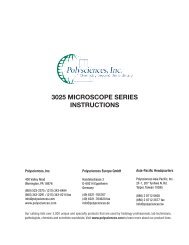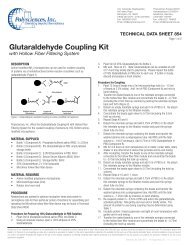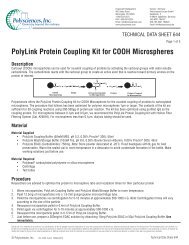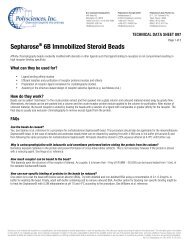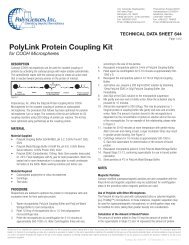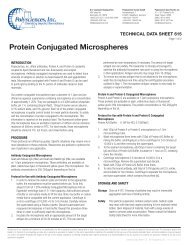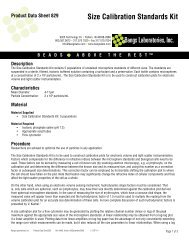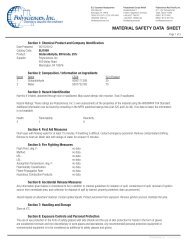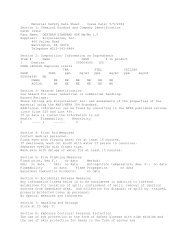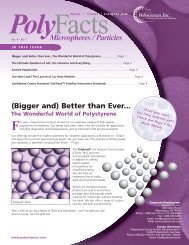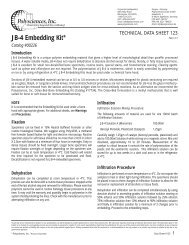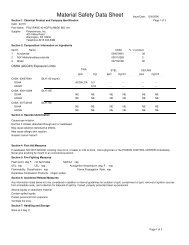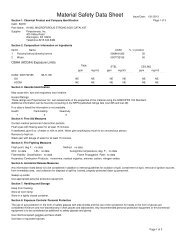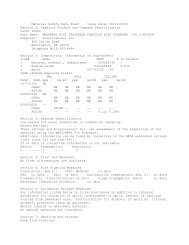Data Sheet #233:Poly/Bed 812 Embedding Media - Polysciences, Inc.
Data Sheet #233:Poly/Bed 812 Embedding Media - Polysciences, Inc.
Data Sheet #233:Poly/Bed 812 Embedding Media - Polysciences, Inc.
You also want an ePaper? Increase the reach of your titles
YUMPU automatically turns print PDFs into web optimized ePapers that Google loves.
Corporate Headquarters<br />
400 Valley Road<br />
Warrington, PA 18976<br />
1-800-523-2575<br />
FAX 1-800-343-3291<br />
Email: info@polysciences.com<br />
www.polysciences.com<br />
Europe - Germany<br />
<strong>Poly</strong>sciences Europe GmbH<br />
Handelsstr. 3<br />
D-69214 Eppelheim, Germany<br />
(49) 6221-765767<br />
FAX (49) 6221-764620<br />
Email: info@polysciences.de<br />
<strong>Poly</strong>/<strong>Bed</strong> ® <strong>812</strong> <strong>Embedding</strong> <strong>Media</strong>/DMP-30 Kit Catalog # 08792-1<br />
<strong>Poly</strong>/<strong>Bed</strong> ® <strong>812</strong> <strong>Embedding</strong> <strong>Media</strong> Catalog # 08791-500<br />
Introduction:<br />
<strong>Poly</strong>/<strong>Bed</strong> ® <strong>812</strong> is designed as a replacement for Epon <strong>812</strong>. With older formulations of Epon <strong>812</strong> it is more difficult to<br />
control the hardness and sectioning quality of the finished blocks. <strong>Poly</strong>/<strong>Bed</strong> ® <strong>812</strong> allows the hardness to be easily<br />
controlled without the variability of the WPE (Weight Per Epoxide) calculations required by Luft in previous protocols.<br />
<strong>Poly</strong>/<strong>Bed</strong> ® <strong>812</strong> can be directly substituted in most formulations with excellent preservation of the cellular structures<br />
required for electron microscopy. Chart 1 on page 3 provides information on WPE.<br />
<strong>Poly</strong>/<strong>Bed</strong> ® allows the tissue sample to be dehydrated with acetone or ethanol, eliminating propylene oxide as an<br />
intermediary for infiltration. This change of reagents reduces the loss of phospholipids by approximately ten percent.<br />
Luft’s Formulations:<br />
Luft 1-5 developed a standardized routine formula for embedding with Epon <strong>812</strong>, which gave the following advantages<br />
over other embedding media 2,3,4<br />
1. Faster penetration of the sample and embedding completed in 24 - 48 hours.<br />
2. Wide range of hardness - varied by changing the ratio of components.<br />
3. Improved contrast - readily stained by osmium tetroxide alone.<br />
4. Easily sectioned in all ranges for Electron Microscopy (EM).<br />
5. Support film not required.<br />
Chart 1 provides Luft's formulas for adjusting the hardness of <strong>Poly</strong>/<strong>Bed</strong> ® <strong>812</strong>. Altering the formula by adding more DDSA<br />
will result in a softer block. Adding more NMA results in a harder block. The formula can be made up in 5X quantities<br />
and stored for future use. This allows more control of the infiltration and embedding solution over time. It will also limit<br />
exposure to hazardous components.<br />
Preparation of <strong>Poly</strong>/<strong>Bed</strong> ® <strong>812</strong> Stock Solution (100ml)<br />
<strong>Poly</strong>/<strong>Bed</strong> ® <strong>812</strong> 51.13g or 48mL<br />
DDSA 27.02g or 31mL<br />
NMA<br />
21.85g or 21mL<br />
DMP-30* 2.00g or 2mL (Added just prior to use.)<br />
TECHNICAL DATA SHEET 233<br />
*Add DMP-30 just prior to infiltration and embedding. Use a tuberculin syringe to exactly measure the volume of<br />
DMP-30. If the quantities given in are divided into equal aliquots of 25mL each, 0.5mL of DMP-30 should be added<br />
for the final solution.<br />
Page 1 of 4<br />
Use the stock solution immediately or store at -20°C in 10cc or 20cc syringes. Freeze the syringes in a horizontal position.<br />
Allow them to thaw completely, at least overnight in a cool, dark area. The quantities indicated can be measured<br />
by either volume or weight. Measure or weigh all components under a hood. The solution should be mixed well prior to<br />
adding DMP-30.<br />
Should any of our materials fail to perform to our specifications, we will be pleased to provide replacements or return the purchase price. We solicit your inquiries concerning all needs for life sciences work. The<br />
information given in this bulletin is to the best of our knowledge accurate, but no warranty is expressed or implied. It is the user’s responsibility to determine the suitability for his own use of the products described<br />
herein, and since conditions of use are beyond our control, we disclaim all liability with respect to the use of any material supplied by us. Nothing contained herein shall be construed as a recommendation to use<br />
any product or to practice any process in violation of any law or any government regulation.<br />
© <strong>Poly</strong>sciences, <strong>Inc</strong>. 0203 RevA <strong>Data</strong> <strong>Sheet</strong> <strong>#233</strong> 1
Infiltration:<br />
Fix tissue according to laboratory protocol and dehydrated through a series of ascending ethanol dilutions to absolute<br />
alcohol. Dehydration with acetone or ethanol will preserve phospholipids better than propylene oxide. Propylene oxide<br />
can be used as an intermediary between the dehydrant and infiltration media, however; it is not required with <strong>Poly</strong>/<strong>Bed</strong> ®<br />
<strong>812</strong>. Changes should be 5 to 10 minutes depending on tissue size and protocol.<br />
Several dilutions of stock <strong>Poly</strong>/<strong>Bed</strong> ® <strong>812</strong> and the dehydrant of choice should be used to assist in complete infiltration by<br />
the embedding solution. Solutions at 3:1 dehydrant to stock solution should be used with a rotating table or wheel to<br />
assure proper infiltration of the specimen. Follow this by a 2:1 mixture, a 1:1 mixture, and finally two changes of the<br />
stock solution of <strong>Poly</strong>/<strong>Bed</strong> ® <strong>812</strong> for the final steps before embedding. The tissue should be in each of these mixtures for<br />
a minimum of one hour and the final step can be overnight. If a rotator is not available the vials containing the tissue<br />
should be mixed several times each hour.<br />
<strong>Embedding</strong> Samples:<br />
The amount of stock solution required for the infiltration/embedding procedure should be prepared by adding the amount<br />
of DMP-30 required for final polymerization.<br />
1. Combine 25mL of stock solution with 0.5mL of DMP-30 and mix well. This should be prepared immediately prior to<br />
use as the DMP-30 can cause the solution to thicken.<br />
2. Transfer tissue to a properly labeled embedding capsules or mold preferred by the laboratory. Tissue should be<br />
oriented in the bottom of the capsule or mold and the embedding solution added. Tissue can be adjusted after the<br />
solution is added to assure proper placement. The capsules or molds should be capped if possible.<br />
3. <strong>Poly</strong>merize in a 60°C oven for 24 hours. Allow the blocks to cool to room temperature before removing the capsule<br />
or mold.<br />
<strong>Poly</strong>/<strong>Bed</strong> ® <strong>812</strong> - Araldite Mixture:<br />
Mollenhauer 6 has used Epon-Araldite mixtures to produce blocks with high image contrast. The blocks were easier to<br />
section than those embedded in either Epon <strong>812</strong> or Araldite alone. <strong>Poly</strong>/<strong>Bed</strong> <strong>812</strong> can be substituted in this formula with<br />
excellent results. Measure all components under a hood.<br />
Standard Mollenhauer Araldite Mixture:<br />
<strong>Poly</strong>/<strong>Bed</strong> ® <strong>812</strong> 100.0ml<br />
Araldite 502<br />
60.0ml<br />
DDSA<br />
18.0ml<br />
DMP-30 5.2ml (Added just prior to use)<br />
Add DMP-30 just prior to use in the amount required for the volume used to infiltrate and embed. A 44.50ml volume of<br />
stock solution would require 1.30ml of DMP-30.<br />
This mixture can be stored in 10cc to 20cc syringes at -20°C for up to two month or at 4°C in an airtight syringe for two<br />
weeks. The syringes should be in a horizontal position to freeze or store.<br />
Dehydration and infiltration should be completed as directed in the standard <strong>Poly</strong>/<strong>Bed</strong> ® <strong>812</strong> directions.<br />
Variation of Mollenhauer Araldite Mixture:<br />
<strong>Poly</strong>/<strong>Bed</strong> ® <strong>812</strong> 10.0 ml<br />
Araldite 502 10.0 ml<br />
DDSA<br />
24.0 ml<br />
DMP-30<br />
0.9 ml (Added just prior to use)<br />
TECHNICAL DATA SHEET 233<br />
Page 2 of 4<br />
Should any of our materials fail to perform to our specifications, we will be pleased to provide replacements or return the purchase price. We solicit your inquiries concerning all needs for life sciences work. The<br />
information given in this bulletin is to the best of our knowledge accurate, but no warranty is expressed or implied. It is the user’s responsibility to determine the suitability for his own use of the products described<br />
herein, and since conditions of use are beyond our control, we disclaim all liability with respect to the use of any material supplied by us. Nothing contained herein shall be construed as a recommendation to use<br />
any product or to practice any process in violation of any law or any government regulation.<br />
© <strong>Poly</strong>sciences, <strong>Inc</strong>. 0203 RevA <strong>Data</strong> <strong>Sheet</strong> <strong>#233</strong> 1
TECHNICAL DATA SHEET 233<br />
Page 3 of 4<br />
Chart 1 - Mixing <strong>Poly</strong>/<strong>Bed</strong> ® <strong>812</strong><br />
WPE is Weight Per Epoxide equivalent. Determine the optimum amount of DDSA or NMA to combine with<br />
100 grams of <strong>Poly</strong>/<strong>Bed</strong> ® <strong>812</strong> resin using this chart for stoichiometric balance. This will minimize un-reacted<br />
starting materials and allow control of the block hardness for sectioning. The exact WPE is listed on the label<br />
of every lot of araldite resin purchased from <strong>Poly</strong>sciences, <strong>Inc</strong>.<br />
The hard mix and soft mix are blended according to the desired hardness of a specific specimen or material.<br />
Per 100 Grams<br />
of <strong>Poly</strong>/<strong>Bed</strong> ® <strong>812</strong><br />
130<br />
140<br />
150<br />
160<br />
170<br />
DDSA Grams for<br />
Softer Blocks Resin<br />
at WPE<br />
112<br />
104<br />
97<br />
91<br />
85<br />
NMA Grams for<br />
Harder Blocks<br />
102<br />
95<br />
89<br />
83<br />
78<br />
Caution:<br />
The toxicological properties of <strong>Poly</strong>/<strong>Bed</strong> ® <strong>812</strong> are not fully known. Prolonged repeated contact of liquid or breathing<br />
vapors or mists may cause delayed and serious injury. Do not get on skin, clothing or in eyes. Avoid inhalation of vapors<br />
and mists. In case of contact with eyes or skin, immediately flush with copious amounts of water for at least 15 minutes;<br />
for eyes get immediate medical attention. Remove contaminated clothing and shoes at once. Clothing should be<br />
destroyed. This product should be used under a hood at all times during the infiltration and embedding process. The<br />
oven required for polymerization should be under a hood or have adequate ventilation. Wear gloves and safety glasses<br />
when handling these components. Wash hands immediately after handling.<br />
References:<br />
1. Kushida, H., Electron Micro., 8, 72, (1959)<br />
2. Finck, H.J., Biophys. and Biochem. Cytol. 7, 27 (1960)<br />
3. Craig, E.L., et al., Cell Biology, 12, 190, (1962)<br />
4. Glauert, A.M., et al., Nature, 178, 803, (1956)<br />
5. Luft, J.J., Biophys. Biochem. Cytol., 9, 409, (1961)<br />
6. Mollenhauer, H.H., Stain Technology, 39, 11, (1964)<br />
7. Juengel, L.I., Proceed. 43rd EMSA, 446, (1985)<br />
8. Stratton, C.J., et al., Tiss., Cell, 14,13 (1982)<br />
9. Hayat, M.A., Principles and Tech. For EM CRC, 94, (1989)<br />
Ordering Information:<br />
Cat. # Description Size<br />
08791-500 <strong>Poly</strong>/<strong>Bed</strong> ® <strong>812</strong> 500gm<br />
087929-1 <strong>Poly</strong>/<strong>Bed</strong> ® <strong>812</strong> (Luft’s Formulation) <strong>Embedding</strong> Kit kit<br />
21958-1 <strong>Poly</strong>/<strong>Bed</strong> ® <strong>812</strong> (Luft’s Formulation) Mini <strong>Embedding</strong> Kit kit<br />
21844-1 <strong>Poly</strong>/<strong>Bed</strong> ® <strong>812</strong> <strong>Embedding</strong> Kit/ - BDMA (Glauert Formulation) kit<br />
21959-1 <strong>Poly</strong>/<strong>Bed</strong> ® <strong>812</strong>/BDMA Mini <strong>Embedding</strong> Kit (Glauert Formulation) kit<br />
02595-1 <strong>Poly</strong>/<strong>Bed</strong> ® Araldite 502 <strong>Embedding</strong> Kit kit<br />
02960-1 <strong>Poly</strong>/<strong>Bed</strong> ® Araldite 502 Mini <strong>Embedding</strong> Kit kit<br />
00553-100 DMP-30 100g<br />
00563-450 Dodecensylsuccinic anhydride (DDSA) 450g<br />
00563-4 Dodecensylsuccinic anhydride (DDSA) 4 x 450g<br />
Should any of our materials fail to perform to our specifications, we will be pleased to provide replacements or return the purchase price. We solicit your inquiries concerning all needs for life sciences work. The<br />
information given in this bulletin is to the best of our knowledge accurate, but no warranty is expressed or implied. It is the user’s responsibility to determine the suitability for his own use of the products described<br />
herein, and since conditions of use are beyond our control, we disclaim all liability with respect to the use of any material supplied by us. Nothing contained herein shall be construed as a recommendation to use<br />
any product or to practice any process in violation of any law or any government regulation.<br />
© <strong>Poly</strong>sciences, <strong>Inc</strong>. 0203 RevA <strong>Data</strong> <strong>Sheet</strong> <strong>#233</strong> 1
00886-450 Nadic methyl anhydride (NMA) 450g<br />
00236-1 Propylene oxide, EM Grade 1pt.<br />
00236-6 Propylene oxide, EM Grade 6 x 1pt.<br />
01914-4 Acetone, EM Grade 99.5% 4 x 1L<br />
09860-1 Reagent Grade Alcohol (100%) 1 gallon<br />
00224-100 BEEM* Capsules Size 00 1pkg of 100<br />
00294-100 BEEM* Capsules Size 00 Conical 1pkg of 100<br />
00336-100 BEEM* Capsules Size 3 1pkg of 100<br />
00295-100 BEEM* Capsules Size 00 Bottle Neck 1pkg of 100<br />
00225-1 Gelatin, <strong>Embedding</strong> capsules Size 00 1pkg of 1000<br />
(23.3mm L x 8.18mm W x 0.95mL volume)<br />
07347-1 Gelatin, <strong>Embedding</strong> capsules Size 1 1pkg of 1000<br />
(19.0mm L x 6.63mm W x .50mL volume)<br />
7348-1 Gelatin, <strong>Embedding</strong> capsules Size 3 1pkg of 1000<br />
(13.9mm L x 5.05mm W 0.21mL volume)<br />
23257-1 BEEM ® , Flat Transparent 1 mold<br />
23256-1 Chien 8 Faced Mold 1 mold<br />
19440-1 Chien Universal Mold 1 mold<br />
0256A-3 BEEM ® Capsule Holders for <strong>Embedding</strong> 3 holders<br />
0256A-12 BEEM ® Capsule Holders for <strong>Embedding</strong> 12 holders<br />
0256B-3 BEEM ® Size 3 Capsule Holders for <strong>Embedding</strong> 3 holders<br />
0256B-12 BEEM ® Size 3 Capsule Holders for <strong>Embedding</strong> 12 holders<br />
08408-1 Capsule, Micron Micromolds (50 units of 10 capsules) 1 pkg<br />
00631-100 Formvar 15/95 (<strong>Poly</strong>[vinyl formal]) 100g<br />
04672-100 Formvar in 0.5% solution in ethylene dichloride 100g<br />
00785-100 Lead (II) Nitrate, 99% for Reynolds Lead Citrate Solution 100g<br />
21447-25 Uranyl Acetate 98%, ACS Grade 25g<br />
BEEM is a registered trademark of Better Equipment for Electron Microscopy, <strong>Inc</strong>.<br />
Diamond Knives are available in all sizes and boat configurations. We have grids in most metals and<br />
patterns for section collection. Please contact for further information, see our catalog or website<br />
To Order:<br />
In The U.S. Call: 1-800-523-2575 • 215-343-6484<br />
In The U.S. FAX: 1-800-343-3291 • 215-343-0214<br />
In Germany Call: (49) 6221-765767<br />
In Germany FAX: (49) 6221-764620<br />
Order online anytime at www.polysciences.com<br />
TECHNICAL DATA SHEET 233<br />
Page 4 of 4<br />
Should any of our materials fail to perform to our specifications, we will be pleased to provide replacements or return the purchase price. We solicit your inquiries concerning all needs for life sciences work. The<br />
information given in this bulletin is to the best of our knowledge accurate, but no warranty is expressed or implied. It is the user’s responsibility to determine the suitability for his own use of the products described<br />
herein, and since conditions of use are beyond our control, we disclaim all liability with respect to the use of any material supplied by us. Nothing contained herein shall be construed as a recommendation to use<br />
any product or to practice any process in violation of any law or any government regulation.<br />
© <strong>Poly</strong>sciences, <strong>Inc</strong>. 0203 RevA <strong>Data</strong> <strong>Sheet</strong> <strong>#233</strong> 1



